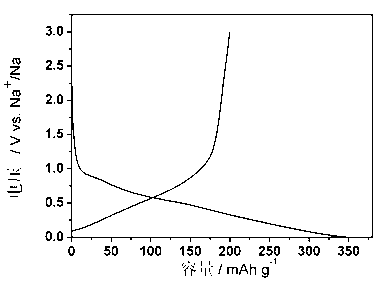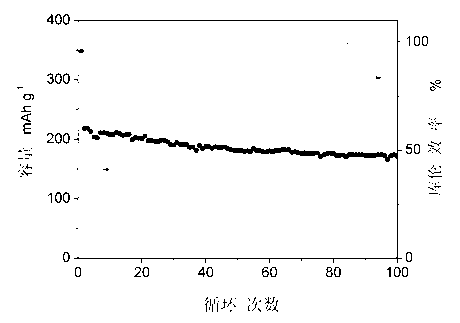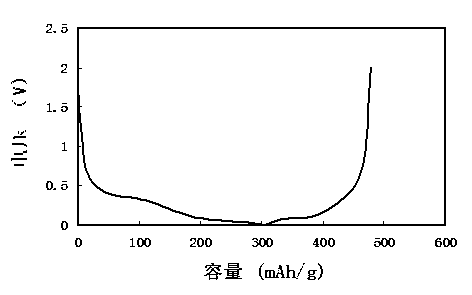Sodion battery cathode material
A sodium-ion battery and negative electrode material technology, which is applied in battery electrodes, secondary batteries, circuits, etc., can solve the problems of less sodium-intercalated negative electrode materials and the inability to effectively insert and extract sodium ions
- Summary
- Abstract
- Description
- Claims
- Application Information
AI Technical Summary
Problems solved by technology
Method used
Image
Examples
Embodiment 1
[0021] Embodiment 1. Polyvinyl chloride pyrolytic carbon and electrochemical sodium storage performance
[0022] Place the polyvinyl chloride material in a high-temperature furnace filled with nitrogen, at 600 o C pyrolysis 6h. The obtained carbon material is uniformly mixed with vinylidene fluoride (PVDF) (dissolved in N-methylpyrrolidone) and acetylene black at a weight ratio of 90:5:5, and coated to form an electrode film. With the electrode film as the working electrode and the metal sodium sheet as the counter electrode, 1mol L -1 NaPF 6 (EC-DEC=1:1) Assembled the battery with the electrolyte to test its electrochemical performance, figure 1 The galvanostatic charge-discharge curve of polyvinyl chloride pyrolytic carbon. Such as figure 1 shown at 50 mA g -1 Under the current density, the reversible capacity of the material is 200mAh g -1 . After 100 cycles of battery cycling, 90% of the capacity is still maintained. ( figure 2 )
Embodiment 2
[0023] Example 2. Preparation and sodium storage performance of polythiophene pyrolytic carbon material
[0024] Place the polythiophene material in a high-temperature furnace filled with nitrogen, at 1200 o C pyrolysis for 10 hours, the obtained carbon material is mixed with vinylidene fluoride (PVDF) (dissolved in N-methylpyrrolidone) and acetylene black in a weight ratio of 90:5:5, and coated into an electrode film. With the electrode film as the working electrode and the metal sodium sheet as the counter electrode, 1mol L -1 NaPF 6 (EC-DEC=1:1) Assembled the battery with the electrolyte to test its electrochemical performance, image 3 It is the galvanostatic cycle performance curve of phenolic resin pyrolytic carbon, the current density is 50 mA g -1 , the charging and discharging voltage range is 2.0~0V (Na + / Na). Such as image 3 The material shown has a reversible capacity of 170mAh g -1 . Figure 4 is the cycle curve of the material. The capacity still main...
Embodiment 3
[0026] Embodiment 3. Preparation and sodium storage performance of polyaniline pyrolytic carbon
[0027] Place the polyaniline material in a high-temperature furnace filled with nitrogen, at 1000 o C pyrolysis for 6 hours, the obtained carbon material is mixed with vinylidene fluoride (PVDF) (dissolved in N-methylpyrrolidone) and acetylene black in a weight ratio of 90:5:5, and coated into an electrode film. With the electrode film as the working electrode and the metal sodium sheet as the counter electrode, 1mol L -1 NaPF 6 (EC-DEC=1:1) Assembled the battery with the electrolyte to test its electrochemical performance, the current density was 50 mA g -1 , the charging and discharging voltage range is 1.2~0V (Na + / Na). The tested material has a reversible capacity of 250 mAh g -1 , the capacity still maintains 220 mAh g after 100 cycles -1 .
[0028]
PUM
| Property | Measurement | Unit |
|---|---|---|
| Reversible capacity | aaaaa | aaaaa |
| Current density | aaaaa | aaaaa |
| Current density | aaaaa | aaaaa |
Abstract
Description
Claims
Application Information
 Login to View More
Login to View More - R&D
- Intellectual Property
- Life Sciences
- Materials
- Tech Scout
- Unparalleled Data Quality
- Higher Quality Content
- 60% Fewer Hallucinations
Browse by: Latest US Patents, China's latest patents, Technical Efficacy Thesaurus, Application Domain, Technology Topic, Popular Technical Reports.
© 2025 PatSnap. All rights reserved.Legal|Privacy policy|Modern Slavery Act Transparency Statement|Sitemap|About US| Contact US: help@patsnap.com



